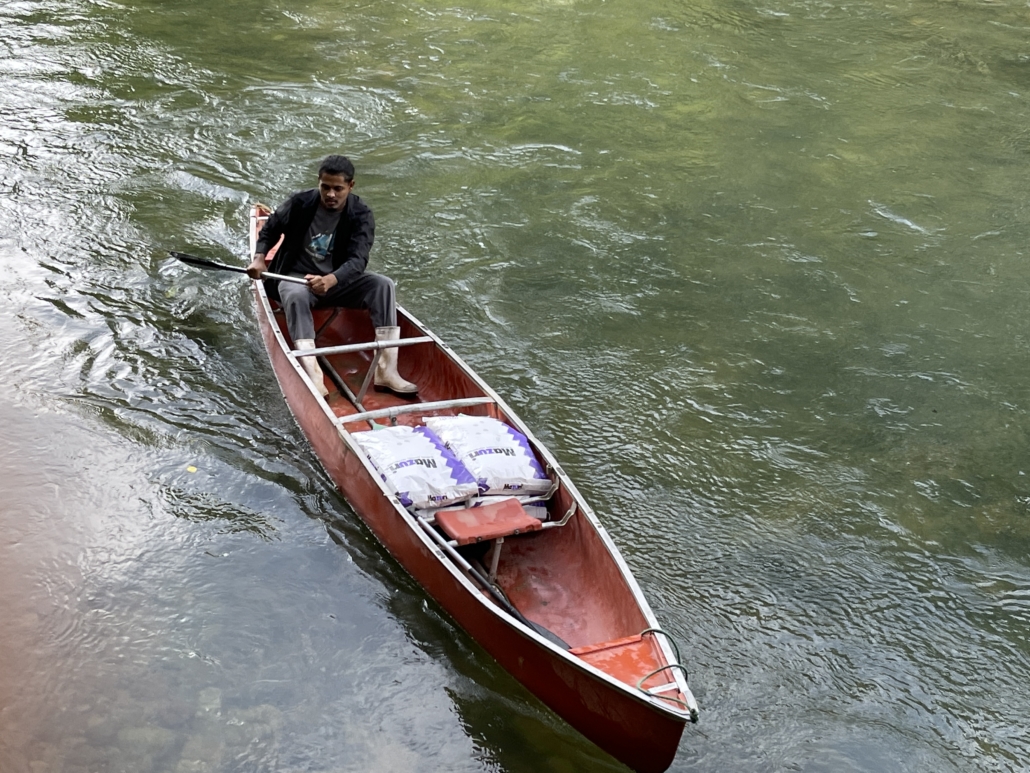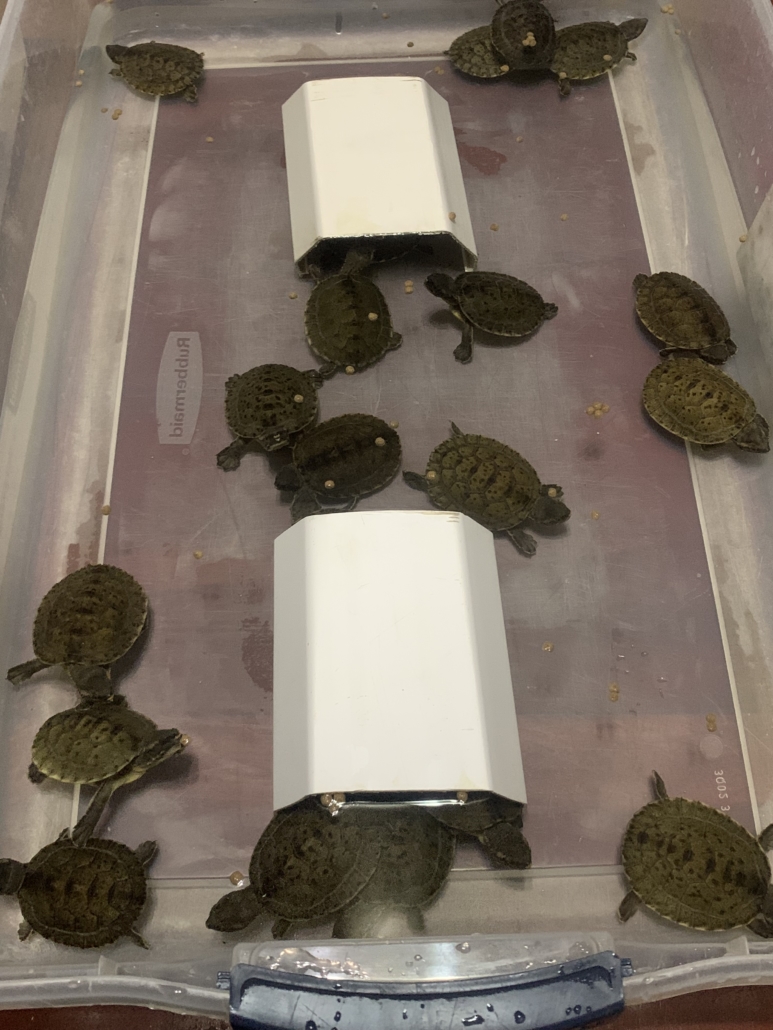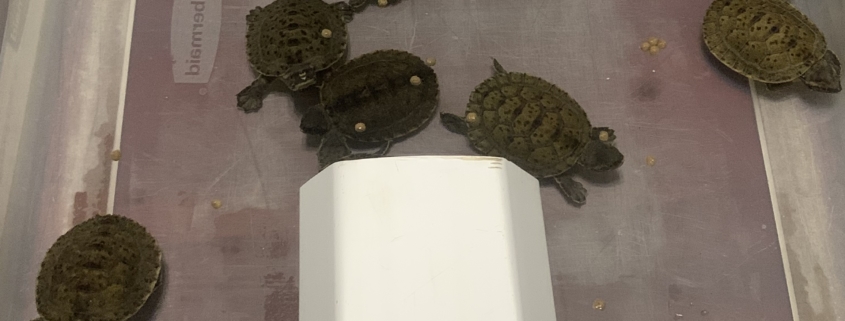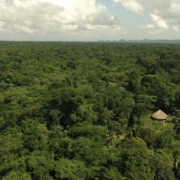The Journey of Nutrition at the HCRC
By Barney Hall, Wildlife Fellow
Dermatemys mawii (Hicatee) hatchlings at the Hicatee Conservation and Research Center (HCRC) are frequently caught during a tour in order to give visitors a hands-on experience and a unique opportunity to hold such a rare turtle. With that being said, each time Tom catches a turtle he quickly analyzes the health of the hatchlings and is pleased when he confirms that the shells are very hard compared to the past hatchlings. You might be curious to know what has changed.
Background
Prior to our work at the HCRC, the hicatee has never been successfully held captive for breeding for any length of time. Past research using dissection of the turtle’s intestinal tract has shown different types of plant vegetation but no indication of carnivorous activity and helps us better understand what they feed on. Because of this, a cycle is done at the facility where Tom and Barney collect fig leaves, cecropia leaves, paspalum grass and occasionally basket tie-tie to try and meet the turtle’s nutritional requirements. However, in the wild there are way more varieties and minerals the turtle could feed on to help them gain calcium carbonate to strengthen their shells. For this very reason research was needed to locate a source to find that missing nutritional component.
Some visitors to the HCRC during a Hicatee Health Assessment recommended we supplement the turtle’s diet with a prepared and specific pre-made turtle food. So, we asked some visitors to bring some Mazuri diet down when they came and we tried it with our hatchlings. When we saw some positive changes, we asked Rick Hudson for help getting more bags to Belize. He jumped in and asked Mark Dennison of Mazuri Turtle Diet for a donation of food to the Belize program. Mazuri turtle diet is a nutritionally complete turtle food for all freshwater species and stages of life. Since it’s a complete diet, all necessary components of a reptile’s nutritional needs are accounted for in its formulation. In fact, all Mazuri diets are formulated by in-house Ph.D Exotic Animal Nutritionists and manufactured to exacting standards to ensure the best quality and complete, constant nutrition for captive held reptiles (Mazuri nutrition 2021).
The food is not available in Belize and we don’t currently have the conditions for long-term storage of large amounts of turtle food (although, thanks to our partner, Zoo New England, we have plans in the works to remedy that). In the meantime, we deal with an elaborate process of ordering bags, getting them imported into Belize and then transported to BFREE.


A New Supply for 2023
This January, Wildlife Fellow Barney Hall and HCRC Manager Tom Pop were able to get in contact with Mr. Mark Dennison again. This was due to Tom’s encounter with Mr. Mark at the 20th Annual Symposium on the Conservation and Biology of Tortoises and Freshwater Turtlesn Tucson, Arizona.
Tom describes his encounter as follows, “We met briefly at the turtle conference last year in Tucson, Arizona. Mark told me he had shipped Mazuri food pellets to Mr. Rick Hudson which were then shipped to Belize. I explained how the pellets arrived to us in Belize and how beneficial they have been to the young hatchlings’ health at the facility. We noticed that our hatchlings were not forming hard shells, meaning that their diet requirements were not being met, until we introduced the Mazuri pellets”. Mr. Mark was very delighted by our efforts and great remarks about the food quality he provides, so immediately offered to donate six more bags of pellets to the HCRC!
We have noticed clear improvements in our turtles’ health at the HCRC, especially our young hatchlings, since beginning to provide Mazuri pellets. We supplement their regular feedings with Mazuri diet and take observations each month to check the progress on shell development. Over time, results have shown that all hatchlings now have very hard shells and seem to have overcome the lack of calcium that was previously impacting their health. The turtles love the pellets and devour the food so very fast that we average one sack of pellets per month. Another great benefit of the pellets is that they float which creates a natural feeding behavior to the young turtles when introduced days after they have hatched. In total, we have successfully released 416 captive-bred healthy turtles back into the wild to areas where they were once abundant to try and augment populations.
A Special Thanks
We very much look forward to receiving the turtle diet in the coming weeks. On behalf of BFREE and the HCRC, we would like to thank Mr. Mark and the team of Mazuri. We hope to build this connection stronger for future collaborations to keep providing the best care and nutrition to the critically-endangered Hicatee turtle.







Leave a Reply
Want to join the discussion?Feel free to contribute!